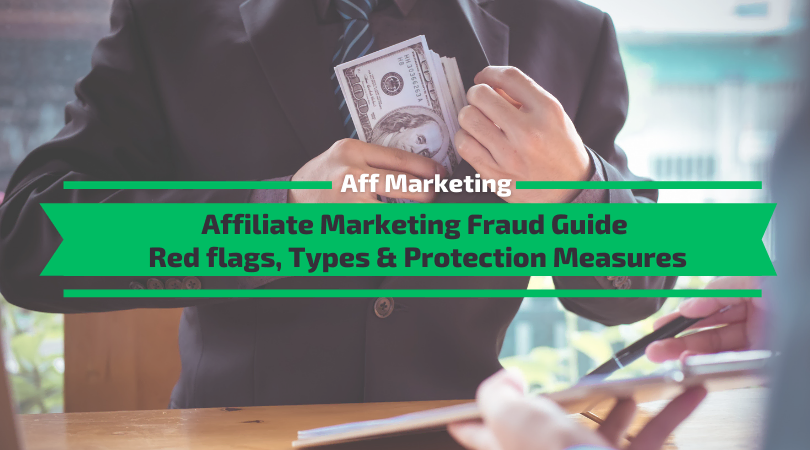It has been estimated that up to 15% of all digital media industry’s revenue comes from affiliate marketing. For instance, eToro, a social investment network, has reportedly paid its affiliates $87 million in commissions since the beginning. According to SimilarWeb, 6% of the hefty 2.5 billion online visits a month Amazon gets arrive from affiliates. But it is not only bells and whistles, as affiliate marketing fraud erodes these numbers badly.
According to Juniper’s Future Digital Advertising, advertisers’ total loss to fraud will rise to $100 billion by 2023. And most of it is to blame affiliate marketing fraud.
Are you worried that your affiliates might be stealing from you? Then it would help if you read this guide.
In the following article, you will learn what affiliate marketing fraud is, the most common types of affiliate fraud, and the signs you should not ignore to prevent fraud.
Ready? Let’s start, then.
Table of Contents
What is Affiliate Marketing Fraud?
Affiliate fraud can be defined as any time an affiliate fakes a conversion (e.g., a sale, lead, install, or click). It can affect both sides of the affiliate industry: legitimate affiliate marketers suffer losses when fraudsters redirect purchases to parasite websites, effectively stealing their commissions, and advertisers lose because they end up paying commissions for fake sales, leads, installs, and clicks.
The rates of fraud in affiliate marketing are highly debated. Indeed, it depends on the type of transaction – for instance, up to 25% of app installs are considered fraudulent, most often due to attribution fraud. The University of Illinois estimated that 38.1% of partners in the Amazon affiliate program engaged in some fraud.
Well, now you know what affiliate marketing fraud is, and I’m sure you are already a little worried, so let’s continue with the most known types of affiliate marketing fraud.
Are you confronted with affiliate marketing fraud? I can help. Check my affiliate marketing consulting service.Types of affiliate marketing fraud
This section will show you the seven most common types of affiliate marketing fraud. I suggest you check them carefully and see if these can apply to you.
1. Cookie stuffing
One of the most common forms of affiliate marketing fraud is cookie stuffing. Cookie stuffing or cookie dropping means a user receives cookies from another website during a visit. The’ stuffer’ will receive a commission when legitimate visitors complete a transaction, such as buying a product or service. But the company that pays hasn’t gained anything as the buyer would have purchased the product in the first place.
When the affiliate places two or more cookies, it’s cookie stuffing. The affiliate can still place cookies when someone visits a site and does not take any active action. In this case, we speak of cookie dropping. Applying this method undermines the commission system because there is no longer a direct line between product and provider.
Most affiliate networks do not permit the use of this method. Offering affiliate cookies via pop-ups, popunders, or iframes is also a method that usually does fall under cookie dropping.
2. Lead Fraud
With lead fraud, the fraudulent affiliate takes advantage of the cost-per-lead (CPL) marketing model, where a marketer pays for every lead generated by the affiliate. Companies that offer services (e.g., insurance companies, lawyers, universities, realtors, etc.) often use this model, and commissions can be lucrative for the affiliate.
Lead fraud occurs when the affiliate generates fake leads, and the advertiser pays for them. Sometimes, the fraudster fills out the forms with phony information, so advertisers lose money on the commission they just paid out, and their time is wasted chasing nonexistent people. In other cases, the fraudster fills out forms with accurate contact information, sometimes from purchased or stolen lists.
This puts advertisers in an awkward situation because they’re reaching out to contacts with no interest in the product or service, resulting in angry interactions, not to mention wasted time.
3. Install Fraud
Install fraud involves the cost-per-install (CPI) marketing model. Here, advertisers pay the affiliate for every install of their app the affiliate generates. This model is often used by brands, gaming companies, and developers looking to target mobile users.
Like other forms of fraud, the install fraudster fakes the installs using bots, malware, or manually installing apps on multiple devices. Sophisticated bots can install apps and forge user actions to make the installation appear legitimate. These fake installs earn fraudsters illegitimate commissions.
One successful company using affiliate marketing, Uber, says it lost more than $70 million through attribution fraud. Following an investigation, former Uber head of performance marketing, Kevin Frisch, says, “We saw no change in our number of rider app installs. We found that many installs we thought had come in through paid channels suddenly came in through organic. I started gaining reports and seeing things that did not make any sense. There is an app that has 1000 monthly active users, and in theory, we got 350,000 installs from them.” Such fraud may involve malware, in which a program “listens” to the user’s activity and is notified once a new app installs starts.
4. Sales Fraud
Sales fraud is based on the cost-per-sale model when an advertiser pays a commission for every sale generated by the affiliate. Fraud occurs when an affiliate fakes a sale – often with stolen credit card information – and collects the commission. Usually, commissions are paid out to the affiliate before the fraud scheme is discovered.
The advertiser is then faced with a chargeback from the credit card company and must return the purchase funds; however, they cannot recover the commission. In other schemes, the fraudsters make several purchases, collect the commissions, and return the products.
5. Misleading Promotions
Misleading promotions is a popular affiliate strategy often used with other tactics on this list. You may have seen YouTube videos that use clickbait thumbnails promising more than the actual content eventually delivers. They do this to dupe the visitors by clicking on the video to increase their view count. As their views increase, so do their advertisement earnings.
Marketers use a similar sort of trick with affiliate promotions as well. They will showcase banners and images likely to attract attention and redirect those visitors to an unrelated affiliate.
Now, visitors don’t appreciate being treated this way, so the disappointed visitors immediately leave the page when this happens. As a result, the affiliate website gets low conversions (sometimes no conversions) from such visits, but still, they have to pay the marketer.
6. Offering Incentives
Some marketers use false incentives to encourage traffic and sales, like misleading promotions. Or they are paying incentives to the users to signup for an offer. For instance, if a casino is paying $300 for a new member who signups up and makes a $50 deposit, the affiliate can offer a $75 incentive to encourage the user to sign up as they will receive $300.
The problem is that the users who sign up are not genuine and will not continue using the service or deposit any more funds.
7. Piggybacking on the brand
In short, piggybacking, if you don’t know the term is to use something that someone else has made or done to get an advantage.
To ensure we are on the same page here in affiliate marketing is ok to use the promotional methods of the seller as long as you have legal permission from the company. But some affiliates are buying Google Ads on search terms where a company or its products are already ranked organically or paying PPC ads.
Also, affiliates can register domain names that are misspellings of merchants’ domain names. When a user misspells a merchant’s domain name in the way that the affiliate anticipated, the user will be sent to the affiliate’s site through an affiliate link and onwards to the merchant. If the user makes a purchase, the affiliate will be credited.
Now that you know the seven most common affiliate marketing types, let’s get our hands dirty and look into affiliate marketing reports and spreadsheets and see if there are any red flags of fraud.
Have you identified any affiliate marketing fraud types? I can help. Check my affiliate marketing consulting service.Red Flags of Affiliate Marketing Fraud
Monitoring your affiliate program for fraud is an ongoing process. Here are eight red flags to help recognize fraud:
1. Unusual High Conversion Rate(CR)
The average conversion rate should be anywhere between 1% – 15%. You should investigate the actions for legitimacy if it’s any higher than that. The conversion rate is specific to niche and product. For example, eCommerce products with a low price will have a higher conversion rate than SAAS products with a high price tag.
2. Clicks leading to action are too fast
Every affiliate tracking platform should show how fast the last click converted into a sale. An average person will take their time shopping online. If the sale happens less than 5 minutes after the shopper is on the site, the affiliate might be stealing that last click and costing the merchant money.
3. Increased Affiliate Complaints/Affiliates Leaving.
Affiliate fraud doesn’t just impact merchants/advertisers. It can hurt honest affiliate partners. Because the credit is going to fraudsters, these affiliates go uncompensated—sparking complaints or even mass desertions of the program.
Also, you should monitor the complaints from the buyers or website visitors. They may complain about spammy emails or apps installed without their consent, etc., and investigate to ensure your affiliates are not involved in fraudulent activities.
4. Affiliate Website doesn’t make sense
The publisher’s site should be promoting products that are similar to yours. For example, suppose the product is Tax Software, and the affiliate has a cat blog listed as their primary traffic source. In that case, this should be investigated as that website may be only a facade, and the affiliate is sending traffic using illicit methods.
5. Country-specific Conversions
Some countries are more liable for sending fraudulent traffic than others. There are schools dedicated to teaching how to “earn” fraudulent commissions. You should investigate the origin of traffic more closely if specific countries are infiltrating your program.
6. Spike in transactions
Did an affiliate go from 1 sale a month to 15 sales? What is the cause? Maybe Google decided to rank them higher organically…or perhaps they are doing something fraudulent to force the sales.
7. Multiple orders from the same IP address
If all the sales from an affiliate come from the same IP location, there must be a good reason for it. More than likely, they are creating fake sales and collecting commissions.
8. Lifetime of customers
This is harder to dig into and is usually specific to MRR model merchants. You should monitor if the customers return products or close accounts soon after paying the affiliate marketer. This is most likely a partner you don’t want to work with.
9. Stagnant Affiliate Program ROI.
Despite increased affiliate spending, fraud activities such as cookie stuffing don’t bring increased business, impacting the ROI for that spend.
10. Where there’s smoke, there’s fire
Several red flags, but no evidence was collected? Inquire about their traffic source and make sure the partner is transparent. If they can’t explain clearly, cut your ties with them.
Have you experienced these red flags of affiliate marketing fraud? I can help. Check my affiliate marketing consulting service.How to protect yourself from fraud
Preventing affiliate fraud is not necessarily complicated if you take the proper steps. It’s better to solve or even plan for issues from affiliates sooner rather than later. Affiliate fraud can get out of hand quickly if you don’t monitor and prevent it.
Take steps to set your program up for success and minimize affiliate fraud.
1. Turn Off Auto-Approve of Affiliates
Fraudsters want to lay in the bushes, unnoticed in the shadows. They will hunt down programs on auto-approve and exploit the holes in the program. This is the first door they look for into infiltrating your program.
For a small company or one that only manages a few affiliates, using a manual approval process for adding affiliates can help limit risks. You can do this by visiting the affiliate’s site and seeing if they align with your brand, verifying that the website is genuine and not a spoofed domain. It can also help check on the individuals within the affiliate’s company.
2. Keep an Eye on Your Conversion Data.
While manually reviewing key conversion metrics can be time-consuming, it is worth it. Your company’s validated conversion rate data can reveal everything you need to know to identify fraud early—and experience in searching for it can help you spot anomalous activity early. It’s essential to complete this process before paying affiliates.
3. Strong Program Terms & Conditions
Fraudsters are looking for programs with weak terms and conditions, especially those with none. You don’t need legalese to be in control, just terms that make it clear that you mean business. You can check what the essential affiliate marketing legal clauses are here.
4. Protect Your Trademark
Savvy affiliates hunt for programs that do not list protected trademarks in their terms and conditions. They will join the program, create some content (maybe), and create PPC campaigns to drive traffic to your site through their affiliate link.
This will drive up the prices of PPC ads, costing that channel more ad spend (plus affiliate commissions). List your trademark keywords and modifications to make it clear to affiliates that this practice won’t be allowed.
5. Use an Ad Fraud Solution.
While technology has armed fraudsters with new tools to commit fraud, it has also given marketers new ways to counter it. Ad fraud solutions can help you monitor traffic in real-time, provide a comprehensive overview of every visitor interacting with your web asset, and identify fraudulent activity immediately. This way, you can identify fraudulent leads before paying affiliates for them.
If you plan to start an affiliate program for WordPress or WooCommerce, we recommend these top 10 affiliate plugins, as some have built-in anti-fraud modules.
Need help stopping affiliate marketing fraud? I can help. Check my affiliate marketing consulting service.Affiliate Marketing Fraud FAQ
Have questions about affiliate marketing fraud? That’s fine, we have answers:
What is affiliate marketing fraud?
What are the main types of affiliate marketing fraud?
What are the main red flags of affiliate marketing fraud?
How I can protect myself from affiliate fraud?
Conclusion
Affiliate fraud will continue to become more sophisticated and difficult to counter. This is why it’s important to proactively work to stop affiliate fraud and keep up to date with the subject’s latest developments.
But now you know what affiliate marketing fraud is and how to identify and prevent it. If you see these signs of fraud, do something about it.
Contrary to popular belief, the affiliate marketing channel is not a set-and-forget marketing channel. Affiliate programs need love and affection to flourish; you can’t just tell your junior marketer to create and run the program when they don’t know what they are doing.
Do you need help?
I’ll gladly help as I am a certified affiliate marketing consultant. Check my affiliate marketing consulting service and get in touch.
 Monetize.info We Help You Grow & Monetize Your Online Business!
Monetize.info We Help You Grow & Monetize Your Online Business!



![Is an Affiliate Program Right for Your Online Business? [PROs & CONs, Examples]](https://monetize.info/wp-content/uploads/2024/07/Is-an-Affiliate-Program-Right-for-Your-Online-Business-310x165.webp)



